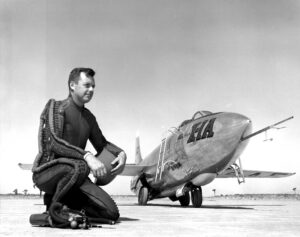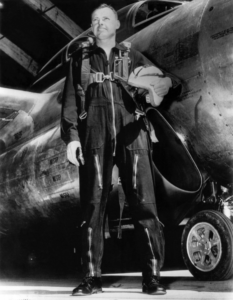4 June 1954 Edwards Air Force Base, California – Major Arthur W. “Kit” Murray flew the experimental Bell X-1A research rocketplane to an altitude of 89,810 feet (27,374 meters). He flew high enough that the sky darkened and he was able to see the curvature of the Earth. Newspapers called him “America’s first space pilot.”
 The X-1A reached Mach 1.97. Encountering the same inertial coupling instability as had Chuck Yeager, 20 November 1953, though at a lower speed, the X-1A tumbled out of control. The rocket plane lost over 20,000 feet (6,100 meters) altitude before Murray could regain control. For this accomplishment, Major Murray was awarded the Distinguished Flying Cross.
The X-1A reached Mach 1.97. Encountering the same inertial coupling instability as had Chuck Yeager, 20 November 1953, though at a lower speed, the X-1A tumbled out of control. The rocket plane lost over 20,000 feet (6,100 meters) altitude before Murray could regain control. For this accomplishment, Major Murray was awarded the Distinguished Flying Cross.
One week earlier, 28 May 1954, Murray had flown the X-1A to an unofficial world record altitude of 90,440 feet (27,566 meters).
Kit Murray enlisted in the Field Artillery, Pennsylvania National Guard, 17 November 1939. (Some sources state that he served in the U.S. Cavalry.) Murray had brown hair and blue eyes, was 5 feet, 10 inches (1.78 meters) tall, and weighed 150 pounds (68 kilograms). Following the United States’ entry into World War II, Sergeant Murray requested to be trained as a pilot. He was appointed a flight officer (a warrant officer rank), Army of the United States, on 5 December 1942. On 15 October 1943 Flight Officer Murray received a battlefield promotion to the commissioned rank of second lieutenant, A.U.S.
Between 6 January and 22 October 1943, Murray flew over 50 combat missions in the Curtiss-Wright P-40 Warhawk across North Africa. After about ten months in the Mediterranean Theater, he returned to the United States, assigned as an instructor flying the Republic P-47 Thunderbolt fighter bomber, stationed at Bradley Field, Hartford, Connecticut.
Murray was the first test pilot to be permanently assigned to Muroc Army Air Field (later, Edwards Air Force Base). Other test pilots, such as Captain Chuck Yeager, were assigned to Wright Field and traveled to Muroc as necessary.
Murray’s A.U.S. commission was converted to first lieutenant, Air Corps, United States Army, on 19 June 1947, with the date of rank retroactive to 15 October 1946. The U.S. Air Force became a separate military service in 1947, and Lieutenant Murray became an officer in the new service.
Murray was involved in testing new Air Force fighters such as the Bell P-59 Airacomet, Lockheed P-80 Shooting Star, Republic P-84 Thunderjet, McDonnell XF-88 Voodoo; and the Douglas XB-43 Jetmaster and North American Aviation B-45 Tornado jet bombers. He also flew the experimental aircraft such as the X-1A, X-1B, X-4, and X-5. Murray spent six years at Edwards before going on to other assignments. Later, 1958–1960, Major Murray was the U.S. Air Force project officer for the North American Aviation X-15 hypersonic research rocket plane at Wright Field.
Colonel Murray retired from the U.S. Air Force in 1961.
Source: Excerpted from: https://www.thisdayinaviation.com/ by Bryan R. Swopes, c.2018
